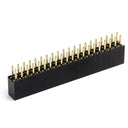Clipper HAT Mini (LTE 4G for Raspberry Pi)
by Pimoroni





Clipper enables your Raspberry Pi computer to receive and transmit data over 4G LTE cellular networks - perfect for remote or mobile projects.
WiFi is great, but sometimes you want your connected project to Just Work, wherever in the world it is. Perhaps you're going to a festival and don't know if there will be wireless connectivity to control your weird LED art installation. Maybe you're trying to get the tech in your shed to talk to your home automation software, but the range of your wireless router won't quite reach. Possibly you're attaching sensors to a distant beehive, canal boat, bicycle or other object with a remote or transient location?
Hooking your Raspberry Pi up to cellular / mobile data could be your solution! Typically, transmitting sensor readings and suchlike doesn't consume much data compared to the needs of modern smartphones, so a small amount of pay-as-you-go data used like this goes a long way.
The mini HAT version of Clipper includes a couple of nice additions for your Raspberry Pi - LED indicators to show you what the LTE module is doing, two user buttons and a Qw/ST connector, which makes it easy to connect up breakouts with a Qwiic or STEMMA QT connector using one of these cables.
Clipper HAT Mini has an SMA connector for attaching an antenna. Antennae are sold separately, so be sure to pick one up!
Features
-
SIMCom A7683E 4G LTE module
- Frequency Bands: LTE-FDD B1/B3/B5/B7/B8/B20/B28
- Control Via AT Commands (SIMCom AT-Command Manual)
- SIM card slot
- Two user buttons (labelled A and B)
- STATUS and NET indicator LEDs
- SMA connector for attaching an antenna
- Qw/ST (Qwiic / STEMMA QT) connector for attaching I2C breakouts
- Unpopulated headers for adding a speaker and microphone
- Pre-soldered socket header for attaching to Raspberry Pi
- No soldering required (as long as your Raspberry Pi has a 40 pin header attached).
- Compatible with Raspberry Pi computers
- Schematic
- Dimensional drawing
Raspberry Pi and accessories are sold separately.
Regional compatibility
The 4G LTE module on Clipper supports the following frequency bands:
B1/B3/B5/B7/B8/B20/B28
If you're planning on using it outside of Europe we'd suggest first checking your local carriers offer 4G LTE on these specific bands. Networks in North America in particular only use a couple of these frequency bands, and so coverage may be limited.
Getting Started
Raspberry Pi OS has a built in ppp library for working with LTE 4G - our handy learn guide will show you how to get it set up.
Notes
- Dimensions: 65 x 30 x 17mm (L x W x D, including connectors). With a Pi Zero 2 W attached with 10mm standoffs, the total depth (including the antenna connector) is around 23mm.
- VDD current consumption info from our testing:
- Idle: 17mA
- Sleep modes: 0.12mA - 1.63mA
- Peak current consumption when transmitting: 700mA (the peak current is only reached for a brief moment, and the 440uF of capacitors on the breakout help to smooth the peaks)
- The average currents we saw when actively using the module were in the 50mA - 100mA range.
- The LTE module has quite a sensitive undervoltage circuit, so if it keeps turning off randomly or when you try and do anything with it check your power supply is up to the task!
-
Clipper HAT Mini (LTE 4G for Raspberry Pi)
PIM717£25.00
Add a LTE 4G antenna
You'll need to attach an external antenna to Clipper.
-
 LTE 4G Antenna+ £3.25
LTE 4G Antenna+ £3.25
Add Raspberry Pi 5 mounting hardware
Use HATs with a Raspberry Pi 5 + Active Cooler combo
-
 Raspberry Pi GPIO Booster Header+ £1.75
Raspberry Pi GPIO Booster Header+ £1.75 -
 Raspberry Pi 5 HAT Boosters (M2.5 Stand offs)+ £2.50
Raspberry Pi 5 HAT Boosters (M2.5 Stand offs)+ £2.50
Shop with confidence – we've been serving the hobbyist electronics, Maker, and retro gaming communities since 2012.
- Satisfaction or refund guarantee
- Worldwide shipping via mail or courier
- 57,000+ customer reviews
- Secure website and payments


